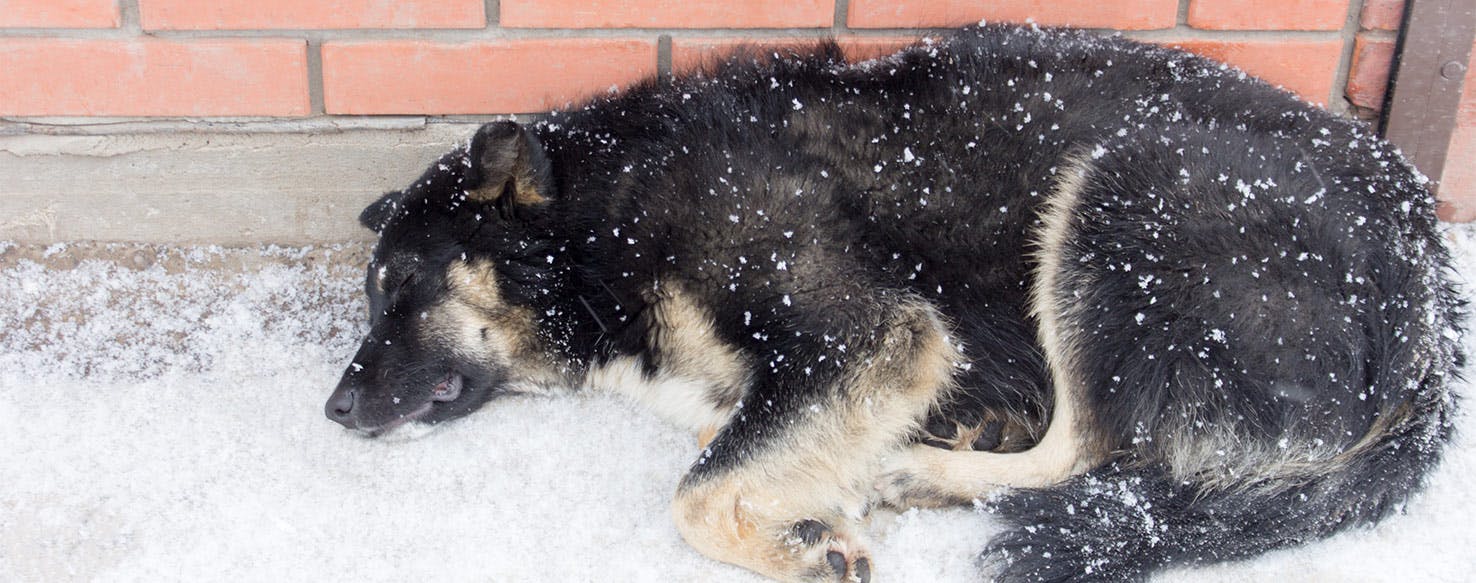
By Darlene Stott
Published: 07/13/2017, edited: 09/07/2022
Save on pet insurance for your pet
You don't have to choose between your pet and your wallet when it comes to expensive vet visits. Prepare ahead of time for unexpected vet bills by finding the pawfect pet insurance.
Overview
When it’s cold outside, we survive by wearing layers, hats, and scarves. We may even indulge in a hot cup of hot chocolate or sit by a roaring fire. However, cold weather isn’t always this idyllic, especially when we begin to consider how our outside pets manage.
Whether your dog spends the majority of their time indoors or outdoors, chances are, you’ve wondered: Can dogs get cold? Surely, that happy-go-lucky temperament combined with all that fur is enough to keep them toasty.
Can dogs get cold outside? Yes!
Even though dogs’ natural body temperature is higher than humans, just like you and me, dogs can and will get cold if left in frigid weather for long periods of time. The curiosity surrounding a dog’s ability to maintain core body temperature may only heighten when considering northern dog breeds, such as Siberian Huskies and Bernese Mountain Dogs. These dogs are bred to withstand freezing temperatures, even to be exposed to them for hours on end, or days when considering dog sledding.
While these dog breeds may be able to remain comfortable in colder temperatures longer than other short-haired breeds, all dogs will become cold and can even gain frostbite or hypothermia from severe exposure.
Is my dog cold outside?
Your dog, despite their thick-padded, heat-insulating paws and double coat, will exhibit signs of low body temperature in similar ways as humans. Most noticeably, dogs will shiver, the body’s way of attempting to get warm. In addition to shivering, there are a few other signs you can look for if you’re worried your dog is cold, such as:
- Whining
- Slow or ceased movement
- Seeking warmth (either from your lap, blankets, or curling up)
- Cold ears
- Extreme sleepiness or lethargy (could be early signs of hypothermia)
Causes of coldness in dogs
Dogs can become cold indoors as well as outdoors. In terms of indoors, dogs are rarely in danger of becoming too cold, even if you keep your home a little cooler than they may like. There’s always a warm, soft dog bed to retire on or a spot of sun to lay under. However, dogs will experience extreme coldness indoors after a bath if not properly dried off.
When your dog’s coat becomes matted with water, it loses many of its heat-insulating qualities. Always be sure to dry off your dog after bath time as thoroughly as possible. You can consider employing a blow-dryer (always used on low heat) if towels can’t get the job done adequately enough.
Diagnosis of coldness in dogs
There’s rarely a case in which you need a professional diagnosis and prognosis for a dog feeling cold. In this case, you are your dog’s caregiver: Pay attention to their temperament, ear temperature, and how much exposure they have to cold weather or air.
However, if you find that your dog is cold often, it could be a sign of poor circulation, which could be a less-known symptom of a heart condition. Additionally, if a dog is left outside in extreme temperatures for long durations, check for signs of hypothermia.
Most pet insurance companies don’t cover pre-existing conditions. To avoid stress and high veterinary care costs, insure your pet today. To avoid high veterinary care costs, secure pet health insurance today and save up to $273 each year.
Want more info on pet health insurance? Check out our guide to pet insurance 101.
How do I treat my dog when cold?
There are a few things you can do to help your pet retain their body temperature, depending on whether they’ve gained the chills from getting wet or being outside.
How to treat your dog if they're cold
- After baths, ensure your dog is either completely dry or nearly dry.
- Before a walk in the snow, put booties on your dog’s paws to help protect them.
- When coming in from a chilly outdoors, help your shivering pup by holding them close and petting them, particularly around the ears.
- For outdoor dogs in the winter, provide a comfortable, warm and dry space for them to retreat during storms or when they become cold. On particularly frigid nights, consider keeping them in the house or provide a heat lamp.
- Consider comfy sweaters for your pooch either around the house and especially in outdoors during winter.
How to recover your dog if they're cold
It shouldn’t take longer than 10-15 minutes for a dog to regain their body temperature after a wintry bout, and you can help speed this process by holding them in your lap or providing a warm, dry spot for them to rest. If shivering continues for a long amount of time, review other possible causes of shivering.
How is getting cold similar in dogs and humans?
Although there are many differences between our anatomy, the general makeup of dogs and humans is very similar. When it comes to getting cold, we both:
- Involuntarily shiver
- Can experience frostbite
- Are at risk of hypothermia
How is getting cold different in dogs and humans?
While our similarities reside in both how we express our chilliness and what extreme conditions we can gain as a result of cold weather, there are some differences in how humans and dogs process cool and warm weather. Unlike humans, dogs have:
-
A higher normal body temperature
-
Insulation and extra padding in their paws to help with walking on hot concrete as well as frigid snow
-
Double coats: two different layers and textures of fur to shelter them from wintry temperatures
You may also like
